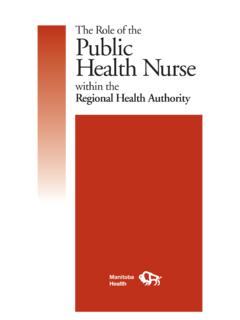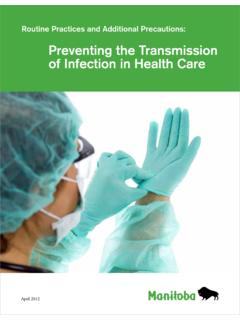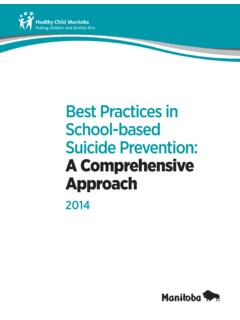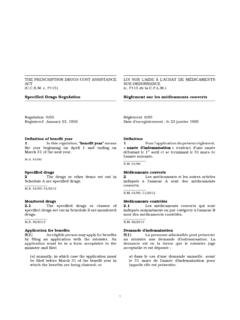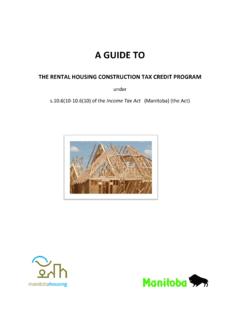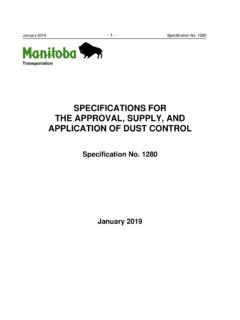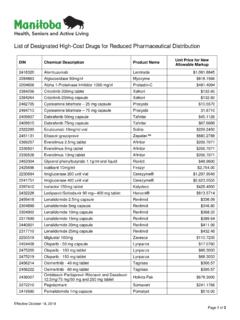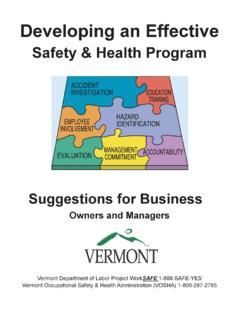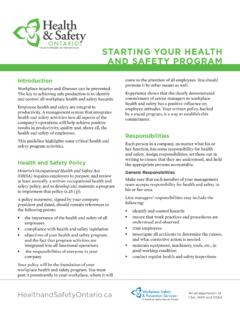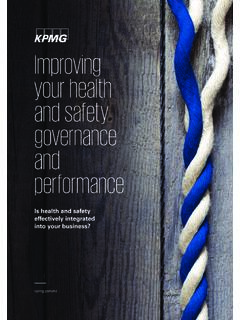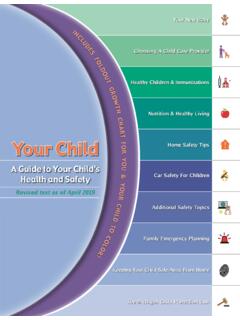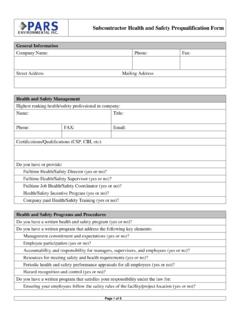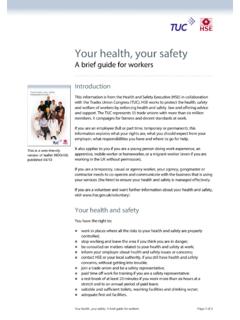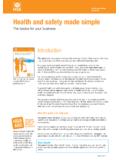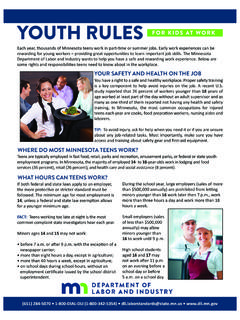Transcription of A Safe Workplace A Workplace Safety and Health Manual for ...
1 A Safe Workplace A Workplace Safety and Health Manual for your Community Page 1 of 7 Section: III-C Rules Procedures, Practices and Guidelines Approved By: Harvey Bostrom Effective: April 01, 2005 Subject: G-12 Fall Protection Revised: April 1, 2011 Refer to The Manitoba Workplace Safety and Health Act and Regulations, Fall Protection and MB WSH Fall Protection Guideline. Council must ensure that an employee is protected from falling: a vertical distance of 3 metres ( ft.) or more; a vertical distance of less than 3 meters where there is an increased risk of injury due to the surface or item in which the worker might land; into operating machinery or moving parts of the machinery; into water or another liquid; into or onto a hazardous substance or object; through an opening on a work surface; or a vertical distance or more than meters from an area used as a path for a wheelbarrow or similar equipment; into water from a boat or platform.
2 A protection system must be implemented to control the hazards to employees. The system selected depends on the circumstances related to the job. Ideally, the choice of a protection system will be one that removes the risk of falling entirely. For example, it is preferable that a fixed barrier is provided to prevent an employee from falling. The second line of defense is personal protective equipment (a Safety harness and lifeline). Fall protection systems can include: surface protection (non-slip flooring); fixed barriers (handrails, guardrails); surface opening protection (removable covers, guardrails); travel restraint systems ( Safety line and belt); fall arrest systems ( Safety line and harness); fall containment systems ( Safety nets); a life jacket including the following rescue equipment: an appropriate boat equipped with a boat hook, a buoyancy device with no less than 15m of 9mm diameter nylon rope and a signaling device; and a full body suit that protects the worker from hypothermia and buoyancy equipment that meets CSA standards, when working on ice where water below is more than 1 metre deep.
3 A Safe Workplace A Workplace Safety and Health Manual for your Community Page 2 of 7 Section: III-C Rules Procedures, Practices and Guidelines Approved By: Harvey Bostrom Effective: April 01, 2005 Subject: G-12 Fall Protection Revised: April 1, 2011 Surface Protection Systems Housekeeping In order to prevent slips and falls work surface must be kept free from tripping and slipping hazards. This can be accomplished by ensuring that good housekeeping practices are instituted at the Workplace . It is important to keep the work area free of equipment and materials that are not required for the task at hand. Slipping and Tripping Hazards Examine the site for slippery or uneven surfaces. Ensure that floors, platforms, walkways, ramps and stairs are maintained in a state of good repair and kept free of slipping and tripping hazards.
4 When a hazard is present prevent the area from being entered and post a sign indicating "no entry" on slip floors Floors that become slippery due to the work operations should be protected with a non-slip type surface or coating that will ensure a secure walking surface. Footwear with special soles may be also required. Material spills must be cleaned up immediately, especially if it creates a slippery surface. Fixed Barrier Protection Systems A fixed barrier must be capable of stopping an employee from proceeding past the edge of a work level or into a floor opening. Barriers may be permanent or temporary, depending on the circumstances at the Workplace . Types of barriers include: guardrails, handrails, ladder, cages, fencing, warning barriers.
5 Guardrail A guardrail is a permanent or portable structural system consisting of a top rail, mid-rail and toe board secured to vertical posts intended to stop an employee from inadvertently stepping off a working level and falling to a level below. Guard railing consists of a top rail at a height of between 900mm and 1060mm (36 to 42 inches) above the working surface with an intermediate rail midway between the top rail and bottom level. The guard railing must be of capable of resisting a static load of 900 Newton's (200 pound force) at any point along the rails. When guard railing is constructed of wood, all members shall be free from splinters and A Safe Workplace A Workplace Safety and Health Manual for your Community Page 3 of 7 Section: III-C Rules Procedures, Practices and Guidelines Approved By: Harvey Bostrom Effective: April 01, 2005 Subject: G-12 Fall Protection Revised: April 1, 2011 protruding nails and at least nominal 50 by 100mm (2" by 4") with a span of no more than metres (8') between posts.
6 Where there is a danger of materials or objects falling from the work surface to a working level below, a toeboard 125 mm (5 inches) in height is required to be secured to the guardrail posts. Guardrail posts must be capable of supporting any loads applied to the top rail. They must be securely attached to the base and braced where necessary to remain solid and secure. Posts are not to exceed a maximum spacing of metres (8 feet) apart. There are many different variations of guardrails, including wood-slat, wire rope, steel frame, Safety fencing, tube and clamp, perimeter netting and others. Any of these variations is acceptable, as long as the system meets the basic design characteristics as mentioned previously.
7 For example, where wire rope (cable) is used for guard railing, it must be tensioned to provide equivalent strength protection as a wooden guardrail system with a top and intermediate rail. When the use of a guardrail system is not reasonably practicable or would not be effective, an employer must ensure that the worker is protected by at least one of the following fall protection systems: a travel restraint system; a fall arrest system; a Safety net; or another fall protection system approved by the director. Warning Barrier Protection Systems A warning barrier is used to indicate to employees that they are approaching a hazardous work area, where a potential to falling exists. The warning barrier is used where it is not reasonably practicable to provide fixed barrier protection, or a guardrail has been temporarily removed from an area.
8 This system may utilize a cable, rope, or a fence system which is set up at least 2 metres from the work surface opening or edge. The effectiveness of this type of system is increased when high visibility flagging or other means is used to mark the warning barrier. A warning system is not a substitute for guard railing as it is usually of lesser strength and offers no protection to the employee who must go near the edge of a work area. Employees who are required to go beyond the warning barrier must use a travel restraint or fall arrest system. Lifelines must not be tied to the warning system or barricade. Handrail Protection Systems On the open side of stairs, ramps and other similar means of access, proper handrails must be provided.
9 These serve as both a physical barrier and a means of support to an employee moving up and down the accessway. A Safe Workplace A Workplace Safety and Health Manual for your Community Page 4 of 7 Section: III-C Rules Procedures, Practices and Guidelines Approved By: Harvey Bostrom Effective: April 01, 2005 Subject: G-12 Fall Protection Revised: April 1, 2011 Handrails should be designed the same as a guardrail, with a top rail, intermediate rail and a toe board where employees may be working below. Surface Opening Protection System Guardrails/floor coverings Surface openings in floors and other walking surfaces where employees have access, must be protected by guard railing or secured wood or metal covers.
10 The covering must be capable of supporting all loads to which it may be subjected. The covering must be identified to indicate that there is an opening below. When plywood is used to cover openings, the minimum thickness shall be 19mm (3/4") with proper support for the plywood. If work must be undertaken near unprotected openings from which an employee could fall 3 metres or more, access must be restricted to employees who are wearing full body Safety harnesses and lifelines secured to proper anchorage. As soon as the necessary work is completed, the opening should be protected by guard railing or adequate covering. If a fixed barrier or surface cover is removed for any reason, proper travel restraint or fall arrest systems must be provided for any employee who becomes at risk of falling.
